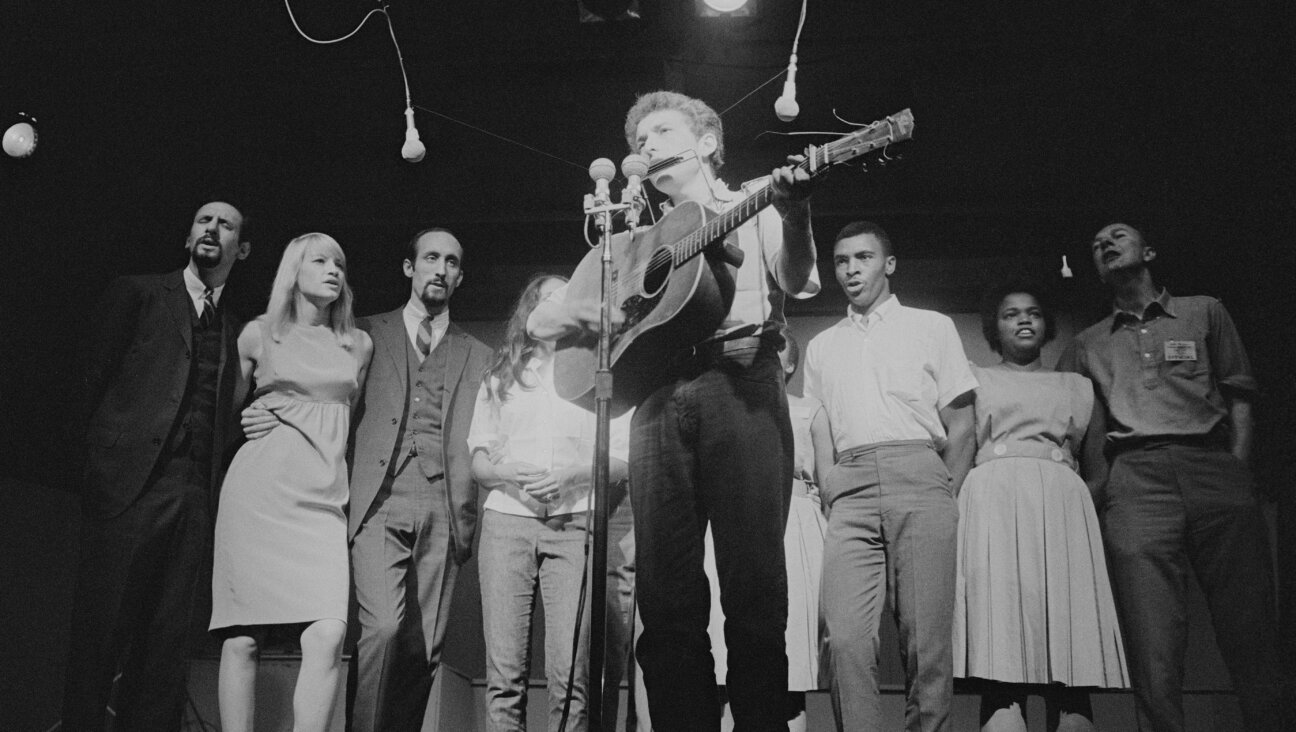One of the Greatest Rock and Roll Songs of All Time was Inspired by a Jewish Bookseller

Graphic by Angelie Zaslavsky
One of the Band’s most enigmatic yet best-known songs is “The Weight.” It’s in the Top 50 of Rolling Stone’s “500 Greatest Songs of All Time”; in the Top 15 of Pitchfork’s “Best Songs of the Sixties”; and one of the “500 Songs That Shaped Rock and Roll,” according to the Rock and Roll Hall of Fame. While it was never a hit single for the Band, versions by Jackie DeShannon and Aretha Franklin garnered extensive sales and airplay in 1968 and 1969, respectively, and an R&B crossover version was released by Diana Ross & The Supremes with The Temptations in 1969. Over a hundred other versions have been performed and recorded since by the likes of the Grateful Dead, Bruce Springsteen, the Chambers Brothers, John Denver, Cassandra Wilson, the Black Keys, Joe Cocker, Miranda Lambert, Weezer, and Jimmy Fallon and the Muppets.
Part of the song’s mystery — and unfamiliarity to many — is embodied in its title: the term “the weight” never appears in the song, whose refrain is “Take a load off Fanny.” Most casual listeners probably assume that phrase is the song’s title; Fanny’s load is presumably “the weight” to which the title refers. Just exactly what it means, however, has long been a mystery.
That is, until now. In an interview with Marc Myers in the Wall Street Journal, Robbie Robertson, the chief songwriter of The Band, reveals the panoply of influences that went into the creation of the song, which appeared on the group’s 1968 debut album, “Music from Big Pink.” As he explains in his recent memoir, “Testimony,” Robertson was an avid fan of European art films in the late 1960s, particularly those of Luis Bunuel, whose surrealistic imagery was often used as commentary on religion, particularly Catholicism. Robertson’s “The Weight” is laden with Biblical imagery; the song is a journey through a superficial American South that resembles Biblical terrain, populated by characters include Luke, Miss Moses, and the Devil.
The song kicks off with a stop in a notable locale: “I pulled into Nazareth, was feelin’ ‘bout half past dead.” It could be the birthplace of Jesus, but Robertson says it was inspired by his 1951 Martin D-28 acoustic guitar. One evening when he was working on the song, he looked inside his guitar and saw that it was made in Nazareth, Pa., where Martin Guitars were and still are constructed. That put Robertson in mind of Bunuel’s film “Nazarin,” which “unlocked a lot of stuff in my head,” he tells Myers. “I just knew I wanted characters to unload their burdens on the song’s main character in each verse. The guy in my song starts by asking the first person he sees in Nazareth about a place to stay the night, a biblical concept.”
Other lyrics of the song, which Robertson wrote while living in a rental house in Woodstock, N.Y., in 1967, referred to other cinematic influences. The image of “Carmen and the Devil walkin’ side by side,” according to Robertson, is borrowed from Ingmar Bergman’s “The Seventh Seal” and the famous chess game with Death.
As for the title character, such as she is, Robertson confirms once and for all that she is “Fanny,” and not “Annie,” as many have often misheard it to be. (Try singing “Take a load off Fanny” to yourself and you can see how the two easily converge). In fact, there was a Fanny upon whom the tune was based. As part of his self-education in European avant-garde cinema, Robertson studied Bergman’s and Bunuel’s film scripts, which he found at the legendary Gotham Book Mart on West 47th Street in Manhattan – located in a neighborhood with which he was already familiar from his days running diamonds from Toronto to New York City on behalf of a Jewish mobster uncle. The bookstore was originally opened on New Year’s Day, 1920, by Frances “Fanny” Steloff, who still ran it when Robertson haunted the film section in the late 1960s. Steloff eventually donated the building to the American Friends of the Hebrew University Foundation. Those film scripts had a huge influence on Robertson both thematically and as a songwriter; they gave him permission to write songs that included jump cuts and fadeouts and used surrealistic symbolism in a particular manner that became Robertson’s trademark, while dealing with questions of God, mortality, and fate. In sum, a far cry from the Band’s origins as a mostly Canadian bar band called the Hawks who backed rockabilly star Ronnie Hawkins on blues and R&B numbers like “Who Do You Love?” and “Further on Up the Road.”
As for the song’s ultimate meaning, Robertson recounts to Myers a conversation with Roebuck “Pops” Staples in 1976, when the Band re-recorded the tune with the Staple Singers for inclusion in the Martin Scorsese-directed farewell concert film, “The Last Waltz” (which just celebrated its 40th anniversary last week on Thanksgiving day). At the session, Pops Staples asked, “Robbie, what’s this song actually about?” Robertson replied, “Pops, you know as well as I do.”
As Robertson recounts, “He looked at me, laughed and said, ‘Go down, Moses’.” As it turns out, the song written by Bob Dylan’s former lead guitarist was a civil rights anthem which, like many before, connected the plight of Southern American blacks to the ancient Israelite slaves, albeit one disguised as a weird country-rock tune. Whether or not the song’s main vocalist, native Arkansan Levon Helm, the only American in the group, had any inkling of this, we will never know — Helm died in 2012.
Seth Rogovoy is a contributing editor at the Forward, and the author of “Bob Dylan: Prophet Mystic Poet” (Scribner, 2009).
















